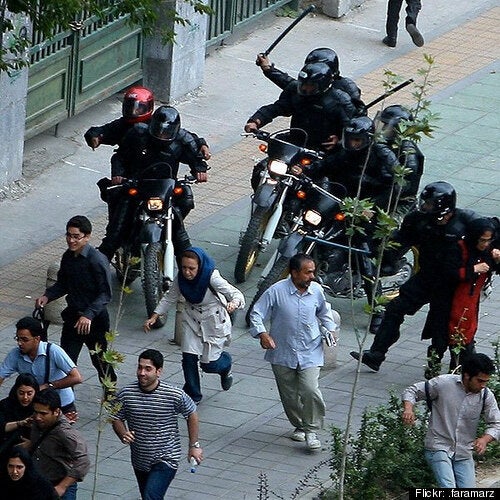
The growing nonviolent insurrection in Iran against the efforts by the ruling clerics to return the ultra-conservative and increasingly autocratic incumbent president Mahmoud Ahmadinjead to power is growing. Whatever the outcome, it represents an exciting and massive outpouring of Iranian civil society for a more open and pluralistic society. Ironically, defenders of Ahmadinejad's repression are trying to blame everyone from the U.S. government to nonviolent theorist Gene Sharp to various small NGOs engaged in educational efforts on strategic nonviolent action as somehow being responsible for the popular uprising in Iran. It appears to be based upon the rather bizarre assumption that millions of Iranians would somehow be willing to pour out onto the streets in the face of violent repression by state security forces only because they have been directed to do so by people from an imperialist power which overthrew their last democratic government and subsequently propped up the tyrannical regime they installed in its place for the next quarter century. Even putting aside the bizarre spectacle of self-proclaimed "leftists" coming to the defense of a right-wing fundamentalist autocratic like Ahmadinejad, this claim ignores several key factors:
One is that neo-conservatives and other American hawks were hoping for a victory by the hard-line incumbent to justify their opposition to President Barack Obama's tentative steps at rapprochement with the Islamic Republic. (See my article "Why American Neo-Cons Want Ahmadinejad to Win") Another is that opposition candidate Mir Hossein Mousavi and the vast majority of his supporters are strongly nationalist, anti-American, anti-imperialist, and would neither desire nor accept U.S. support. (See my article "Iran's Stolen Election Has Sparked an Uprising") Most importantly, there has been a longstanding Iranian tradition of such largely nonviolent civil insurrections against imperialist powers and autocratic rulers and no outside power is needed to convince the Iranian people to rebel. Indeed, the idea of Americans having to teach Iranians about massive nonviolent resistance is like Americans teaching Iranians to cook fesenjan. Most Iranians - who have traditionally been very proud of their political, social and cultural history - would find it rather bizarre to learn that some Western bloggers, ignorant of that very history, are insisting that the recent protests are a result not of their own anger at an apparent stolen election and continued autocratic rule, but simply because some Americans have told them to. In reality, uprisings like the one witnessed in recent days have occurred with some regularity in Iran since the late 1800s. In 1890, unpopular concessions on tobacco and other products to the British led leading Shia clerics to call for nationalist protests and a nationwide tobacco strike, which succeeded in forcing the Shah to cancel the concession in early 1892. In 1905, in opposition to widespread corruption by the Qajar dynasty and allied regional nobles and a series of other concessions to Russian and other foreign interests, an uprising initially led by merchants and clergy ensued which would continue for the next six years. In what became known as the Constitutional Revolution, many thousands of Iranians engaged in peaceful protests, boycotts and mass sit-ins, along with occasional riots and scattered armed engagements. The result was significant political and social reforms, including the establishment of an elected parliament to share power with the Shah and anti-corruption measures. A CIA-sponsored coup in 1953 ousted the elected nationalist prime minister Mohammed Mossadegh and his nationalist supporters and returned the exiled Shah to power as an absolute monarch. Through mass arms transfers from the United States, Shah Mohammed Reza Pahlavi built one of the most powerful armed forces ever seen in the Middle East. His American-trained secret police, the SAVAK, had been thought to have successfully terrorized the population into submission during the next two decades through widespread killings, torture and mass detentions. By the mid-1970s, most of the leftist, liberal, nationalist, and other secular opposition leadership had been successfully repressed through murder, imprisonment or exile, and most of their organizations banned. It was impossible to suppress the Islamist opposition as thoroughly, however, so it was out of mosques and among the mullahs that much of the organized leadership of the movement against the Shah's dictatorship emerged.
Open resistance began in 1977, when exiled opposition leader Ayatollah Ruhollah Khomeini called for strikes, boycotts, tax refusal and other forms of noncooperation with the Shahs regime. Such activism was met with brutal repression by the government. The pace of the resistance accelerated as massacres of civilians were answered by larger demonstrations following the Islamic 40-day mourning period. In the months that followed, Iranians employed many of the methods that would be used in the unarmed insurrections that toppled dictatorships in the Philippines, Latin America, Eastern Europe and elsewhere in subsequent years: mass demonstrations, strikes, boycotts, contestation of public space, and the establishment of parallel institutions.
Despite the bloody image of the revolution and the authoritarianism and militarism of the Islamic Republic that followed, there was a clear commitment to keeping the actual insurrection largely nonviolent. Protestors were told by the leadership of the resistance to try to win over the troops rather than attack them; indeed, thousands of troops deserted, some in the middle of confrontations with crowds. Clandestinely smuggled audio cassette tapes of Ayatollah Khomeini speaking about the revolution played a key role in the movement's mass mobilization, and led Abolhassan Sadegh, an official with the Ministry of National Guidance, to note that "tape cassettes are stronger than fighter planes." Ayatollah Khomeini's speeches, circulated through such covert methods, emphasized the power of unarmed resistance and noncooperation. In one speech, he said, "The clenched fists of freedom fighters can crush the tanks and guns of the oppressors." There were few of the violent activities normally associated with armed revolutions such as shooting soldiers, setting fires to government buildings or looting. Such incidents that did occur were unorganized and spontaneous and did not appear to have the support of the leadership of the movement. In October and November of 1978, a series of strikes by civil servants and workers in government industries crippled the country. The crisis deepened when oil workers struck at the end of October and demanded the release of political prisoners, costing the government $60 million a day. An ensuing general strike on November 6 paralyzed the country. Even as some workers returned to their jobs, disruption of fuel oil supplies and freight transit, combined with shortages of raw materials resulting from a customs strike, largely kept economic life in the country at a standstill.
Despite providing rhetorical support for an improvement in the human rights situation in Iran, the Carter administration continued military and economic support for the Shah's increasingly repressive regime, even providing fuel for the armed forces and other security services facing shortages due to the strikes.
Under enormous pressure, the oil workers returned to work but continued to stage slowdowns. Later in November, the Shah's nightly speeches were interrupted when workers cut off the electricity at precisely the time of his scheduled addresses. Massive protests filled the streets in major cities in December as oil workers walked out again and an ongoing general strike closed the refineries and the central bank. Despite thousands of unarmed protesters being killed by the Shah's forces, the protesters' numbers increased, with as many as nine million Iranians taking to the streets in of cities across the country in largely nonviolent protests. The Shah fled on January 16, 1979, and Ayatollah Khomeini returned from exile two weeks later. He appointed Mehdi Bazargan prime minister, thus establishing a parallel government to challenge the Shah's appointed prime minister Shapur Bahktiar. With the loyalty of the vast majority clearly with the new Islamic government, Bahktiar resigned February 11.
One element that contributed to people's willingness to mobilize under harsh repression was the value of martyrdom in Shia Islam. The movement's emphasis was to "save Islam by our blood." Indeed, there are interesting parallels between the legacy of martyrdom inspired by early Shia leader Imam Hossein with the Gandhian tradition of self-sacrifice. As demonstrated by their subsequent rule, the Iranian revolution's leadership - unlike Mohandas Gandhi - clearly did not support nonviolence as a principle, but recognized its utilitarian advantages against the well-armed security apparatus of the Shah's regime.
While the revolution had the support of a broad cross-section of society (including Islamists, secularists, nationalists, laborers, and ethnic minorities), Khomeini and other leading Shia clerics strengthened by a pre-existing network of social service and other parallel institutions consolidated their hold and established an Islamic theocracy. The regime shifted far to the right by the spring of 1981, purging moderate Islamists including the elected president Abolhassan Bani-Sadr and imposing a totalitarian system.
Now, a new generation of Iranians is rising up in the tradition of previous generations using largely nonviolent tactics to challenge their oppression. Those out on the streets in Tehran, Isfahan, Tabriz, and other cities are not just middle class intellectuals but also represent a broad cross-section of the poor and working class and include both the majority Persians as well as other ethnicities. It is not clear whether the opposition can successfully organized a "people power" revolution of the kind which succeeded in ousting autocrats who attempted to steal elections in such countries as the Philippines in 1986, Serbia in 2000, or Ukraine in 2005 or whether - as in Azerbaijan, Belarus, and Mexico - the regime will remain in power. In any case, it is clearly a home-grown indigenous struggle. Any effort by the United States (which has allowed one --and possible two--stolen elections to stand in recent years) to intervene will only hurt the pro-democracy movement. Given the history of U.S. interventionism in Iran, Obama's cautious approach will do more to help those in the current popular struggle than anything more explicit, despite Republican demands to the contrary.
The future of Iran belongs in the hands of the Iranians and the best thing the United States can do to support a more open and pluralistic society in that country at this point is to stay out of the way.
